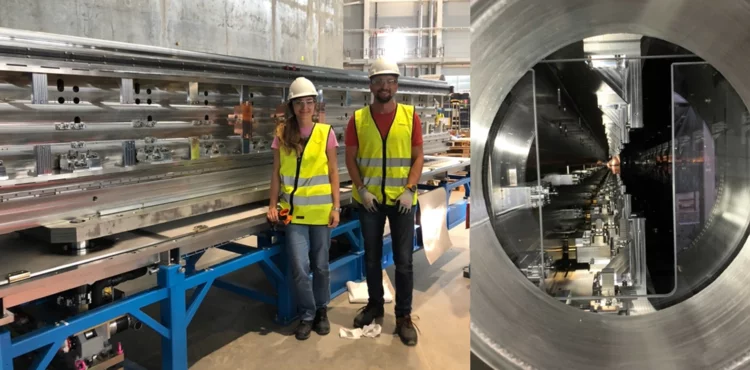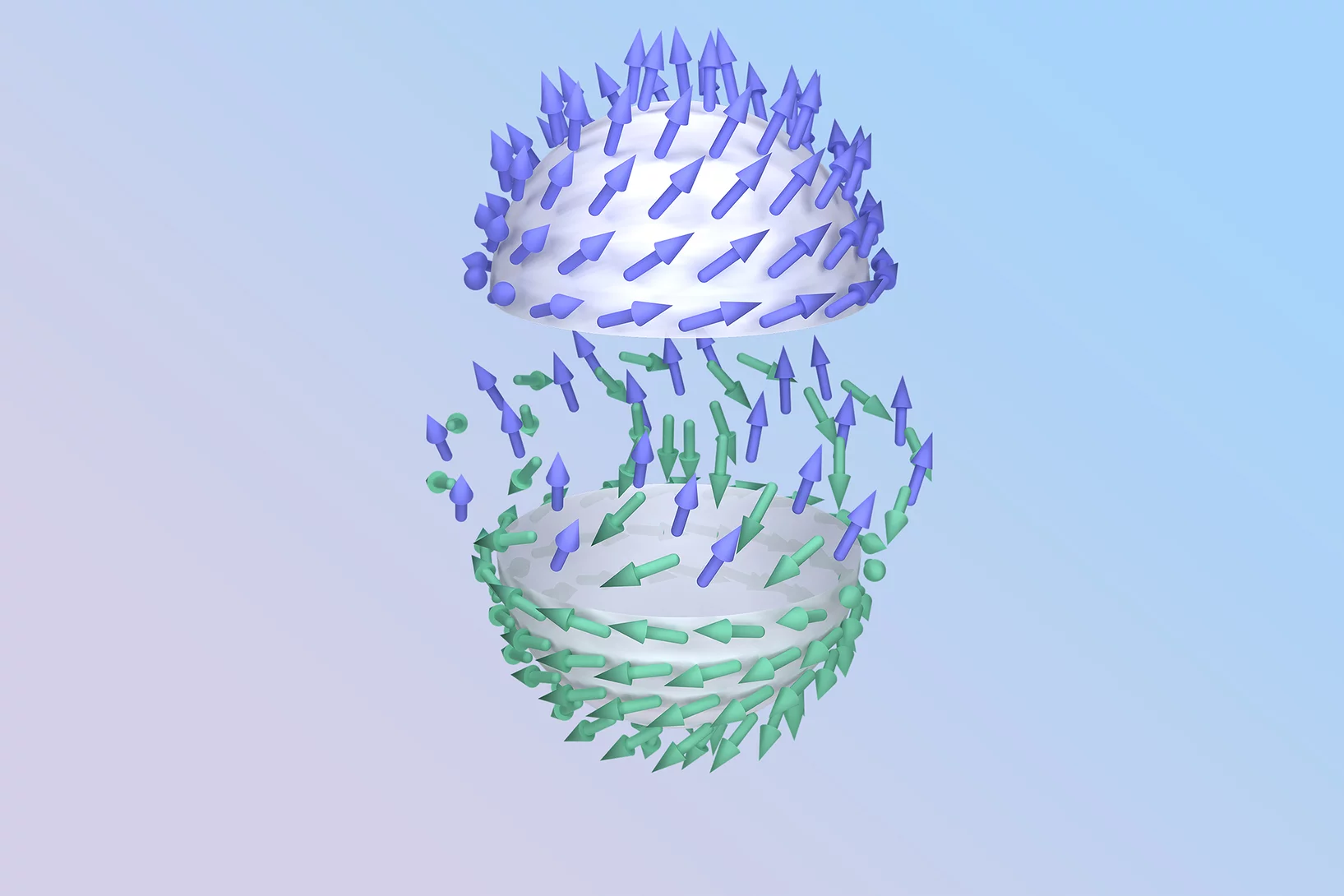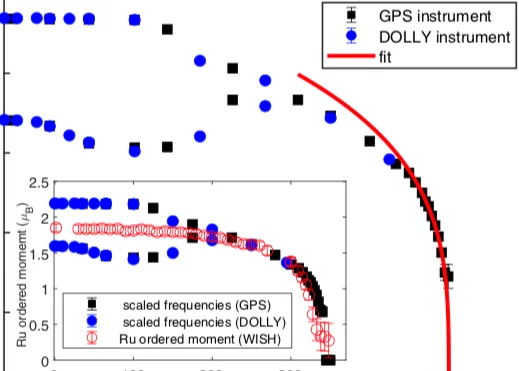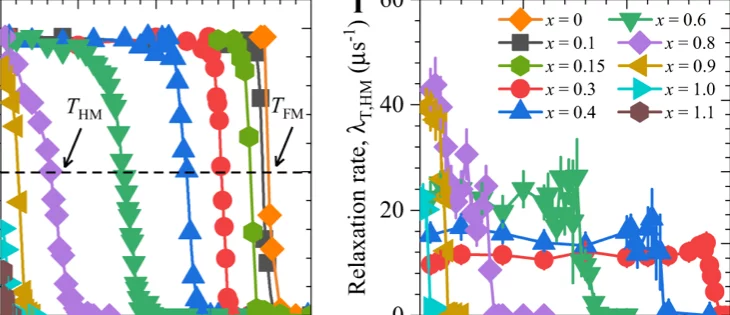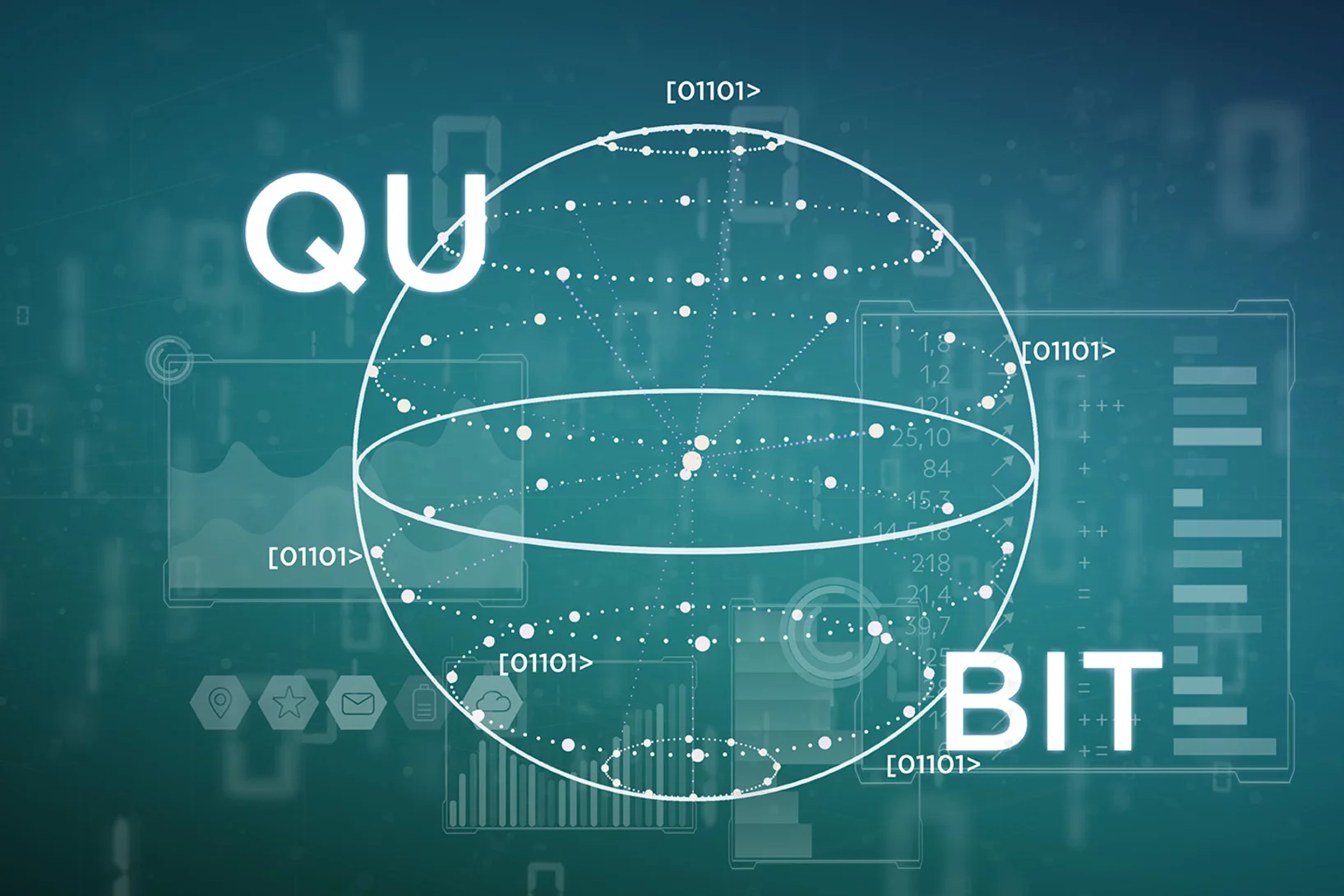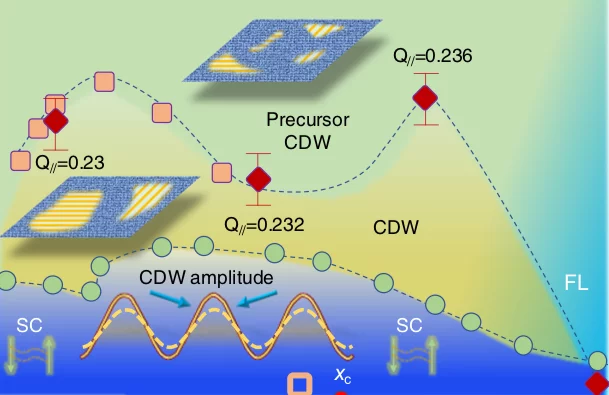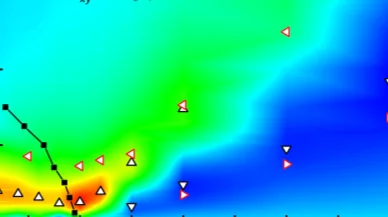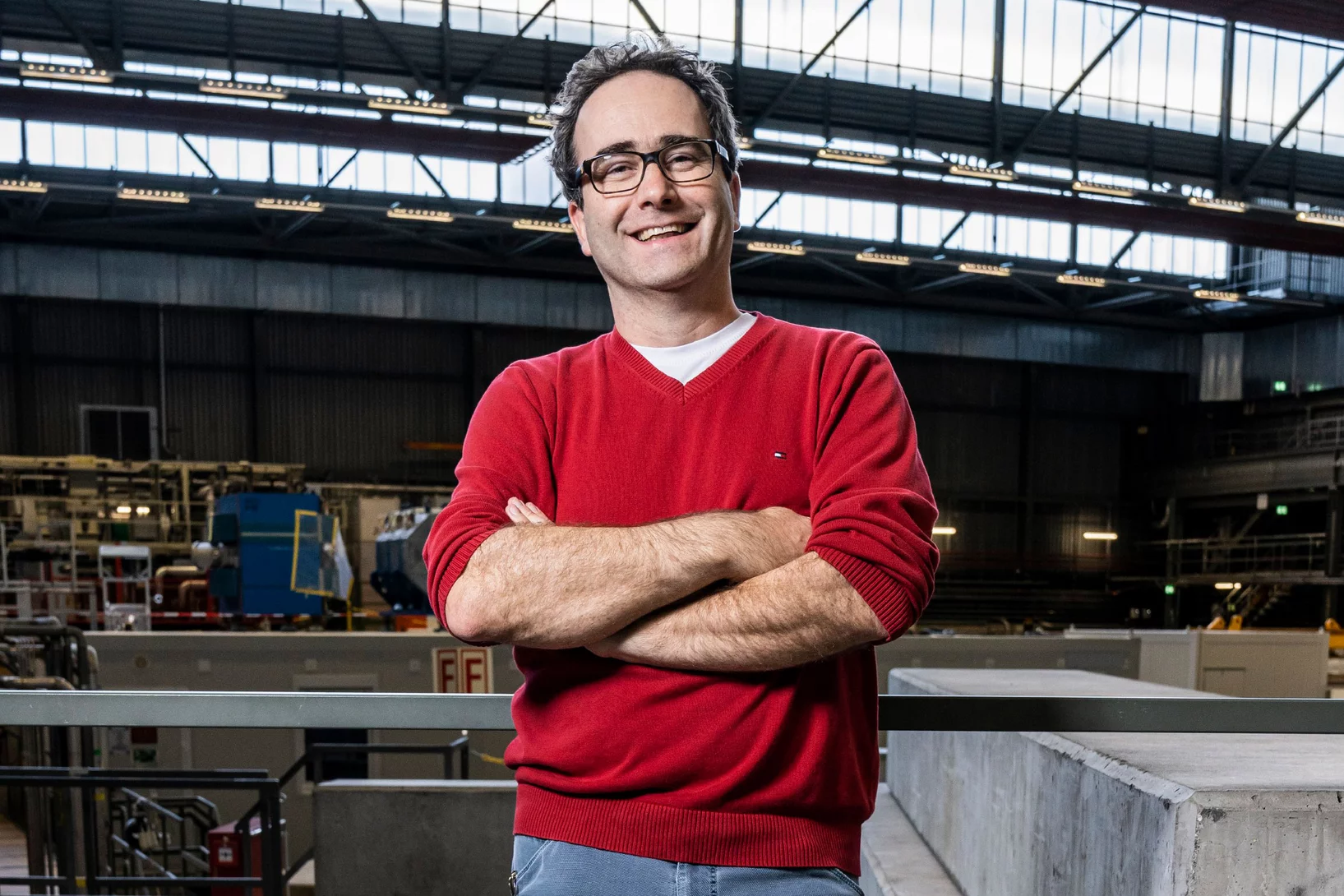Here you find current and previous news from the PSI Center for Neutron and Muon Sciences.
Soft-mode dynamics in the ferroelectric phase transition of GeTe
GeTe that exhibits a strong anharmonicity and a ferroelectric phase transition between the rhombohedral and cubic structures has emerged as one of the leading thermoelectric materials. Herein, combining molecular dynamics simulations and inelastic neutron scattering measurements, the lattice dynamics in GeTe have been investigated to reveal the soft-mode mechanisms across the phase transition.
First Components of ESTIA arrive at ESS
The European Spallation Source (ESS) is currently under construction in Lund, Sweden and is set to become the most powerful neutron source in Europe and world-wide. The PSI-ESS project is delivering state-of-the-art contributions to five instruments at ESS, which will be home to a suite of 15 novel instruments. Among the five PSI instruments, the reflectometer ESTIA stands out as it is delivered in its entirety by PSI ...
Vital role of magnetocrystalline anisotropy in cubic chiral skyrmion hosts
Magnetic anisotropy is anticipated to govern the formation of exotic spin textures reported recently in cubic chiral magnets, like low-temperature tilted conical and skyrmion lattice (SkL) states and metastable SkLs with various lattice geometry. Motivated by these findings, we quantified the cubic anisotropy in a series of CoZnMn-type cubic chiral magnets. We found that the strength of anisotropy is highly enhanced towards low temperatures. Moreover, not only the magnitude but also the character of cubic anisotropy drastically varies upon changing the Co/Mn ratio.
Unsplit superconducting and time reversal symmetry breaking transitions in Sr2RuO4 under hydrostatic pressure and disorder
There is considerable evidence that the superconducting state of Sr2RuO4 breaks time reversal symmetry. In the experiments showing time reversal symmetry breaking, its onset temperature, TTRSB, is generally found to match the critical temperature, Tc, within resolution. In combination with evidence for even parity, this result has led to consideration of a dxz ± idyz order parameter.
Magnetic nanoworld
At PSI, researchers come across exotic phenomena such as frustrated magnets and nano-vortices, which may one day enable better data storage.
Two scenarios for superconductivity in CeRh2As2
CeRh2As2, a nonsymmorphic heavy fermion material, was recently reported to host a remarkable temperature versus z-axis magnetic-field phase diagram with two superconducting phases. In this material, the two inequivalent Ce sites per unit cell, related by inversion symmetry, introduce a sublattice structure corresponding to an extra internal degree of freedom. In this work, we propose a classification of the possible superconducting states in CeRh2As2 from the two Ce-sites' perspective.
RENiO3 Single Crystals (RE = Nd, Sm, Gd, Dy, Y, Ho, Er, Lu) Grown from Molten Salts under 2000 bar of Oxygen Gas Pressure
Schematic representation of the method used to grow RENiO3 nickelate single crystals covering the full 4f series and Y. This novel procedure, based on the use of moderate oxygen gas pressures (2000 bar), solvothermal growth in a temperature gradient, and highly reactive eutectic salt mixtures as fluxes, yields prismatic-shaped crystals with flat facets and sizes up to ∼75 μm.
Giant phonon anomalies in the proximate Kitaev quantum spin liquid α-RuCl3
The Kitaev quantum spin liquid epitomizes an entangled topological state, for which twoflavors of fractionalized low-energy excitations are predicted: the itinerant Majorana fermion and the Z2 gauge flux. It was proposed recently that fingerprints of fractional excitations are encoded in the phonon spectra of Kitaev quantum spin liquids through a novel fractional- excitation-phonon coupling. Here, we detect anomalous phonon effects in α-RuCl3 using inelastic X-ray scattering with meV resolution.
Unconventional chiral charge order in kagome superconductor KV3Sb5
Intertwining quantum order and non-trivial topology is at the frontier of condensed matter physics. A charge- density-wave-like order with orbital currents has been pro- posed for achieving the quantum anomalous Hall effect in topological materials and for the hidden phase in cuprate high-temperature superconductors. However, the experimental realization of such an order is challenging. Here we use high-resolution scanning tunnelling microscopy to discover an unconventional chiral charge order in a kagome material, KV3Sb5, with both a topological band structure and a superconducting ground state.
Magnetic and electronic ordering phenomena in the Ru2O6-layer honeycomb lattice compound AgRuO3
The silver ruthenium oxide AgRuO3 consists of honeycomb Ru25+O62− layers and can be considered and can be considered an analogue of SrRu2O6 with a different intercalation. We present measurements of magnetic susceptibility and specific heat on AgRuO3 single crystals, which reveal a sharp antiferromagnetic transition at 342(3) K. The electrical transport in single crystals of AgRuO3 is determined by a combination of activated conduction over an intrinsic semiconducting gap of ≈100 meV and carriers trapped and thermally released from defects.
High-resolution neutron imaging reveals kinetics of water vapor uptake into a sessile water droplet
Various imaging methods in materials research have pursued the characterization of material composition and its change in space and time. When it comes to liquid matter far from equilibrium, such as mixing and evaporating mixtures of solutes and solvents, of paramount importance in diverse solution-processing methods, the quantitative and in situ characterization remains challenging. Our research with the evaporating ...
Laser-induced transient magnons in Sr3Ir2O7 throughout the Brillouin zone
Ultrafast manipulation of magnetic states holds great promise for progress in our understanding of new quantum states and technical applications, but our current knowledge of transient magnetism is very limited. Our work elucidates the nature of transient magnetism in gapped antiferromagnets using Sr3Ir2O7 as a model material. We find that transient magnetic fluctuations are trapped throughout the entire Brillouin zone while remaining present beyond the time that is required to restore the original spin network.
Multiple quantum phase transitions of different nature in the topological kagome magnet Co3Sn2−xInxS2
The exploration of topological electronic phases that result from strong electronic correlations is a frontier in condensed matter physics. One class of systems that is currently emerging as a platform for such studies are so-called kagome magnets based on transition metals. Using muon spin-rotation, we explore magnetic correlations in the kagome magnet Co3Sn2−xInxS2 as a function of In-doping, providing putative evidence for an intriguing incommensurate helimagnetic (HM) state. Our results show that, while the undoped sample exhibits an out-of-plane ferromagnetic (FM) ground state, at 5% of In-doping the system enters a state in which FM and in-plane antiferromagnetic (AFM) phases coexist.
Chiral singlet superconductivity in the weakly correlated metal LaPt3P
Chiral superconductors are novel topological materials with finite angular momentum Cooper pairs circulating around a unique chiral axis, thereby spontaneously breaking time-reversal symmetry. They are rather scarce and usually feature triplet pairing: a canonical example is the chiral p-wave state realized in the A-phase of superfluid He3. Chiral triplet super- conductors are, however, topologically fragile with the corresponding gapless boundary modes only weakly protected against symmetry-preserving perturbations in contrast to their singlet counterparts. Using muon spin relaxation measurements ...
Charge Condensation and Lattice Coupling Drives Stripe Formation in Nickelates
Revealing the predominant driving force behind symmetry breaking in correlated materials is sometimes a formidable task due to the intertwined nature of different degrees of freedom. This is the case for La2−xSrxNiO4+δ, in which coupled incommensurate charge and spin stripes form at low temperatures. Here, we use resonant x-ray photon correlation spectroscopy to study the temporal stability and domain memory of the charge and spin stripes in La2−xSrxNiO4+δ.
Frustration-driven magnetic fluctuations as the origin of the low-temperature skyrmion phase in Co7Zn7Mn6
Magnetic skyrmions in chiral cubic helimagnets, are stabilized by thermal fluctuations over a narrow region directly below the magnetic ordering temperature. Due to often being touted for use in applications, there is high demand to identify new mechanism that can expand the equilibrium skyrmion phases where these topological vortices may display an enhanced robustness against external perturbations, such as magnetic fields, due to a larger magnetic order parameter.
Probing the superconducting gap structure in the noncentrosymmetric topological superconductor ZrRuAs
The superconducting gap structure of the topological superconductor candidate ZrRuAs with a noncen- trosymmetric crystal structure has been investigated using muon-spin rotation/relaxation (μSR) measurements in transverse-field (TF) and zero-field (ZF) geometries. Magnetization, electrical resistivity, and heat capacity measurements reveal bulk superconductivity below a superconducting transition temperature Tc = 7.9(1) K.
Water and quantum magnets share critical physics
At high pressure, liquid water and water vapour merge together – the phase boundary disappears. Researchers have now discovered a similar behaviour in a quantum magnet.
A quantum magnetic analogue to the critical point of water
At the liquid–gas phase transition in water, the density has a discontinuity at atmospheric pressure; however, the line of these first-order transitions defined by increasing the applied pressure terminates at the critical point, a concept ubiquitous in statistical thermodynamics. In correlated quantum materials, it was predicted and then confirmed experimentally that a critical point terminates the line of Mott metal–insulator transitions, which are also first-order with a discontinuous charge carrier density. In quantum spin systems, continuous quantum phase transitions have been controlled by pressure, applied magnetic field and disorder, but discontinuous quantum phase transitions have received less attention.
Spin-singlet to triplet Cooper pair converter interface
Combining magnetic and superconducting functionalities enables lower energy spin transfer and magnetic switching in quantum computing and information storage, owing to the dissipationless nature of quasi-particle mediated supercurrents. Here, we put forward a system where emergent spin-ordering and diffusion of Cooper pairs are achieved at a non-intrinsically magnetic nor superconducting metallo-molecular interface.
Hercules School 2021 at PSI
During the week of March 15 – 19, we had the pleasure to welcome 20 international PhD students, PostDocs and assistant professors at PSI, taking part in the first virtual Hercules School on Neutrons & Synchrotron Radiation.
Observation of novel charge ordering and spin reorientation in perovskite oxide PbFeO3
PbMO3 (M = 3d transition metals) family shows systematic variations in charge distribution and intriguing physical properties due to its delicate energy balance between Pb 6s and transition metal 3d orbitals. However, the detailed structure and physical properties of PbFeO3 remain unclear. Herein, we reveal that PbFeO3 crystallizes into an unusual 2ap × 6ap × 2ap orthorhombic perovskite super unit cell with space group Cmcm.
Charge density waves in cuprate superconductors beyond thecritical doping
The unconventional normal-state properties of the cuprates are often discussed in terms of emergent electronic order that onsets below a putative critical doping of xc≈0.19. Charge density wave (CDW) correlations represent one such order; however, experimental evidence for such order generally spans a limited range of doping that falls short of the critical value xc, leading to questions regarding its essential relevance. Here, we use X-ray diffraction to demonstrate that CDW correlations in La2−xSrxCuO4 persist up to a doping of at least x=0.21.
Split superconducting and time-reversal symmetry-breaking transitions in Sr2RuO4 under stress
Strontium ruthenate (Sr2RuO4) continues to present an important test of our understanding of unconventional superconductivity, because while its normal-state electronic structure is known with precision, its superconductivity remains unexplained. There is evidence that its order parameter is chiral, but reconciling this with recent observations of the spin part of the pairing requires an order parameter that is either finely tuned or implies a new form of pairing. Therefore, a definitive resolution of whether the superconductivity of Sr2RuO4 is chiral is important for the study of superconductivity.
Strong Superexchange in a d^(9−δ) Nickelate Revealed by Resonant Inelastic X-Ray Scattering
The discovery of superconductivity in a d9−δ nickelate has inspired disparate theoretical perspectives regarding the essential physics of this class of materials. A key issue is the magnitude of the magnetic superexchange, which relates to whether cuprate-like high-temperature nickelate superconductivity could be realized. We address this question using Ni L-edge and O K-edge spectroscopy of the reduced d9−1/3 trilayer nickelates R4Ni3O8 (where R = La, Pr) and associated theoretical modeling.
The Swiss research infrastructure for particle physics CHRISP
Researchers are looking for deviations in the current standard model of physics and want to find out how our universe is constructed.
Decomposing Magnetic Dark-Field Contrast in Spin Analyzed Talbot-Lau Interferometry: A Stern-Gerlach Experiment without Spatial Beam Splitting
We have recently shown how a polarized beam in Talbot-Lau interferometric imaging can be used to analyze strong magnetic fields through the spin dependent differential phase effect at field gradients. While in that case an adiabatic spin coupling with the sample field is required, here we investigate a nonadiabatic coupling causing a spatial splitting of the neutron spin states with respect to the external magnetic field. This subsequently leads to no phase contrast signal but a loss of interferometer visibility referred to as dark-field contrast.
Unconventional Transverse Transport above and below the Magnetic Transition Temperature in Weyl Semimetal EuCd2As2
As exemplified by the growing interest in the quantum anomalous Hall effect, the research on topology as an organizing principle of quantum matter is greatly enriched from the interplay with magnetism. In this vein, we present a combined electrical and thermoelectrical transport study on the magnetic Weyl semimetal EuCd2As2. Unconventional contribution to the anomalous Hall and anomalous Nernst effects were observed both above and below the magnetic transition temperature of EuCd2As2, indicating the existence of significant Berry curvature.
Size of helium nucleus measured more precisely than ever before
In experiments at the Paul Scherrer Institute PSI, an international research collaboration has measured the radius of the atomic nucleus of helium five times more precisely than ever before. The researchers are publishing their results today in the journal Nature.
Size of helium nucleus measured more precisely than ever before
In experiments at the Paul Scherrer Institute PSI, an international research collaboration has measured the radius of the atomic nucleus of helium five times more precisely than ever before. The new value can be used to test fundamental physical theories.



